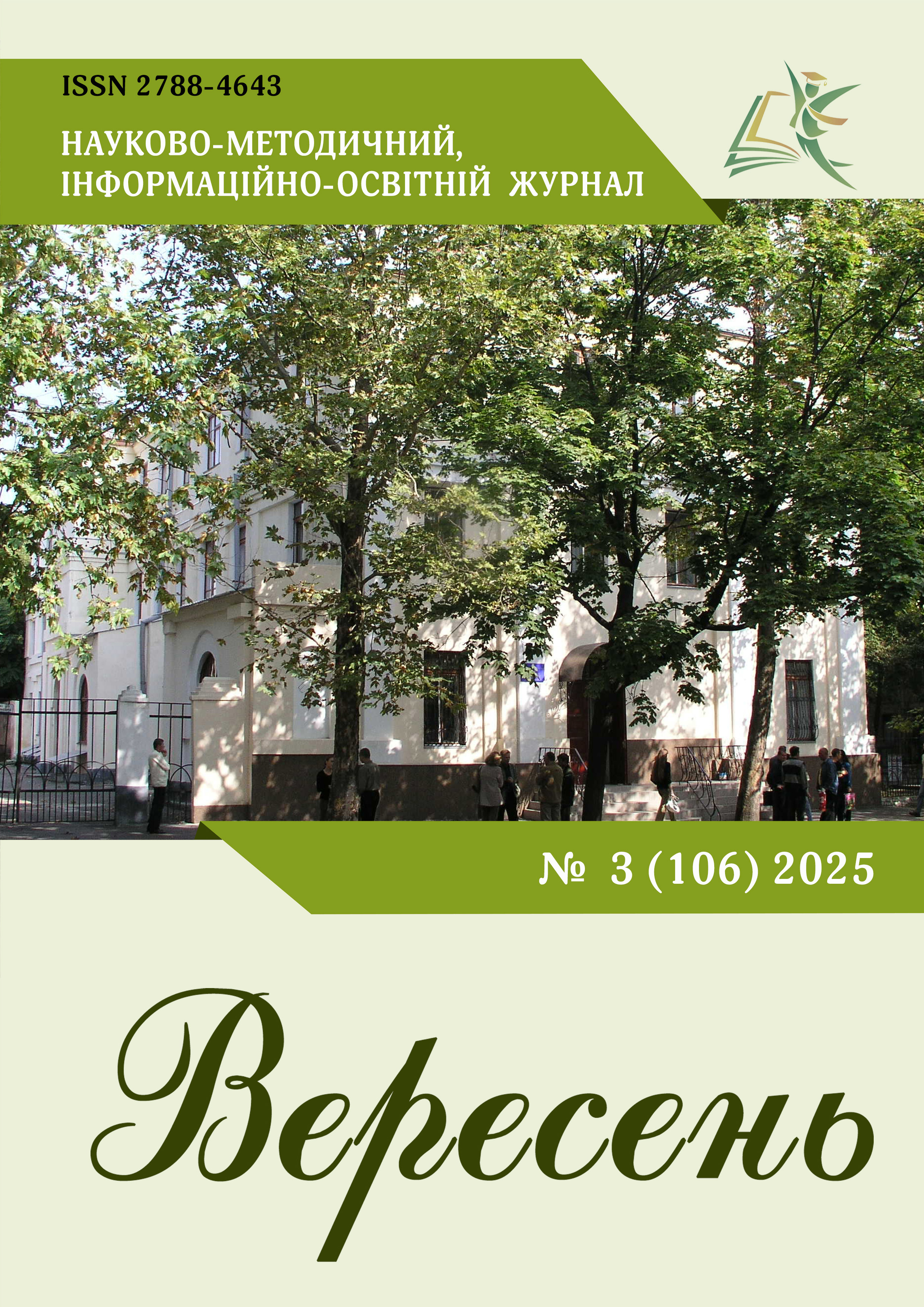«GENDER KALEIDOSCOPE» IN A DOLL’S HOUSE
DOI:
https://doi.org/10.54662/veresen.3.2025.03Keywords:
gender, «gender couple», «gender kaleidoscope», «gender role», «man-man», «man-woman», «woman-woman»Abstract
The article is a continuation of the study of gender issues in the drama of the outstanding Norwegian writer Henrik Ibsen, A Doll’s House, which we began in a previous work published in the scientific journal «Veresen» («September»). That study clarified the originality of the playwright’s treatment of issues concerning the place and role of women in his contemporary society. This time, we focus on the problem of the «gender kaleidoscope», a term we introduced in our research practice, which refers to the changes that occur in the gender behavior of the characters under the influence of relevant events. We proceed from the assumption that the events and conflicts depicted in the play do not change the characters fundamentally, but only highlight traits inherent in each male and female character that were previously hidden. Unlike the previous investigation, which examined changes in the behavior and worldview of Nora Helmer and Christina Linne, here we explore more complex interactions between characters. We analyze both «intra-gender» interactions — within male and female pairs of characters — and «inter-gender» interactions, focusing on two pairs: Torvald and Nora Helmer, and Christina Linne and Krogstad. We identify the features of «gender behavior» of female and male characters, on the basis of which we determine the «gender changes» within the male-female pairs. It is the noticeable changes in the gender behavior of the characters, considered in a historical context and occurring in both intra-gender and inter-gender pairs through their comparison, that allow us to assert that the drama presents a «gender kaleidoscope», in which seemingly stable «pictures» change depending on the angle from which they are viewed. The article argues not for the randomness of these changes, but for their determination by the characters’ personalities and by the author’s moral and aesthetic position.
References
Gigi Engle, G. & Weiss, S. What to Know About the «Hotwifing» Kink in Open Relationships. Retrieved from https://www.menshealth.com/sex-women/a38278676/what-is-a-hotwife/ (eng).
Henrik Ibsen – tvorets sotsialno-psykholohichnoi dramy [Henrik Ibsen is the creator of socio-psychological drama.]. Retrieved from. http://surl.li/kzxtsq (ukr).
Hladyshev, V. V. (2011). Avtor, tvir, suspilstvo (Deshcho pro vyvchennia dramy H. Ibsena «Lialkovyi dim») [Author, work, society (Something about the study of G. Ibsen's drama «A Doll's House»)]. Slovianoznavstvo v kulturnomu prostori ХХI stolittia. Materialy V naukovo-praktychnoi konferentsii do dnia slovianskoi pysemnosti ta kultury. Mykolaiv: MNU imeni V. O. Sukhomlynskoho, 68–76 (ukr).
Hladyshev, V. V. (2024). Deiaki henderni pytannia piesy Henrika Ibsena «Lialkovyi dim» [Some gender issues in Henrik Ibsen's play «A Doll's House»]. Veresen, 4 (103), 3–14. DOI: https://doi.org/10.54662/veresen.4.2024.01. Mykolaiv: MOIPPO (ukr).
Hladyshev, V. V. (2006). Teoriia i praktyka kontekstnoho vyvchennia khudozhnikh tvoriv u shkilnomu kursi zarubizhnoi literatury [Theory and practice of contextual study of works of art in the school course of foreign literature]. Mykolaiv: Vyd-vo «Ilion» (ukr).
Ibsen, H. Lialkovyi dim [A Doll's House]. Retrieved from: http://surl.li/gyoybu (ukr).
Kopystianska, N. Kh., & Todchuk, N. Ye. (2000). U poshukakh vidpovidei na vichni pytannia (Strukturni paraleli: Henrik Ibsen («Lialkovyi dim») – Ivan Franko («Dlia domashnoho ohnyshcha») [In search of answers to eternal questions (Structural parallels: Henrik Ibsen («A Doll's House») – Ivan Franko («For the Home»)]. Vsesvitnia literatura v serednikh navchalnykh zakladakh Ukrainy, 4, 47–49 (ukr).
Mishchuk, V. I. (2023). Dim, u yakomu vianut pochuttia (Do vyvchennia sotsialno-psykholohichnoi dramy H. Ibsena «Lialkovyi dim» («Nora»). 10 klas) [The House in Which Feelings Wither (To the Study of the Social and Psychological Drama of H. Ibsen «A Doll’s House» («Nora»). Grade 10)]. Vidrodzhennia. Movy, literatury, istoriia narodiv Ukrainy v natsionalnykh shkolakh, 11, 11–13 (ukr).
Möbіus, P. (1909). Fizіologicheskoe slaboumіe zhenshchini [Physiologically retarded women]. Soch. D-ra P Möbіusa. Moskva: Sfinks (rus).
pidkazok Erikha Fromma tym liudiam, kotri shukaiut spravzhniu liubov [Erich Fromm's 15 tips for people looking for true love]. Retrieved from: http://surl.li/ixzxex (ukr).
Shevchenko, L. O. & Kobikova, Yu. V. (2015). Hender u psykholohichnykh ta sotsialnykh doslidzhenniakh [Gender in psychological and social research]. Kharkiv: Kharkivskyi natsionalnyi universytet vnutrishnikh sprav (ukr).
Shuliar,V. I. (2024). Noomodel intelihentnoho chytacha [Noomodel of an intelligent reader]. Mykolaiv: tsentr redaktsiino-vydavnychoi diialnosti MOIPPO (ukr).
Stepanova, E. R. (2017). Sutnist ta pokhodzhennia poniattia «hender» [The essence and origin of the concept of «gender»]. Suchasni problemy upravlinnia pidpryiemstvamy: teoriia ta praktyka. Retrieved from: http://surl.li/uslcqk (ukr).
Tlumachnyi slovnyk ukrainskoi movy [Explanatory dictionary of the Ukrainian language]. Retrieved from. http://surl.li/hleqlz (ukr).
Tsiko, I. H. (2004). Pokaz shliakhu stanovlennia osobystosti v doli Nory. Urok za dramoiu H. Ibsena «Lialkovyi dim» [Showing the path of personality formation in the fate of Nora. A lesson based on the drama of H. Ibsen «A Doll's House»]. Zarubizhna literatura v navchalnykh zakladakh, 7, 37–38 (ukr).
Zarubizhni pysmennyky. Entsyklopedychnyi dovidnyk. U 2 t. (2025). [Foreign writers. Encyclopedic reference book. In 2 vols]. T. 1: A–K / (Еd. N. Mykhalskа & B. Shchavursky). Ternopil: Navchalna knyha–Bohdan (ukr).




